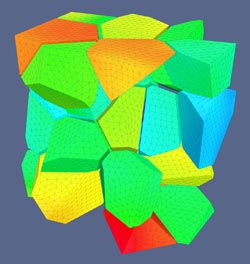Silicon Chip "Replaces" Rare Earths

A balanced perspective on classical theories of philosophical gender research. Source: Thomas Schrefl<br>
However, their use for this purpose can be optimised and thereby reduced. This has been demonstrated in computer simulations by a Special Research Program funded by the Austrian Science Fund FWF.
The results, which will be presented in the US tomorrow, show that such magnets may contain local deformations in the crystal lattice of the material. These deformations are above all located at the boundary of material grains. According to the calculations of the St. Pölten University of Applied Sciences, the magnetic force of the material is weakened in these areas. This could be avoided by optimising the material structure, which would save resources by reducing the amount of rare earths required.
With an annual production of 150,000 tonnes, rare earths are really not that rare. The real problem is that they are rather difficult to extract. In view of rapidly growing global demand, a shortage is therefore imminent. Due to their particular chemical properties, rare earths are sought after for modern environmental technology. This is a good reason for the main exporter, China, to limit exports – and for other countries to optimise their use of the resource. High-end computer simulations, such as the computations from St. Pölten University of Applied Sciences, carried out as part of an FWF-funded Special Research Program, could make a major contribution to this optimization. Tomorrow, at the annual meeting of the US Minerals, Metals & Materials Society in San Diego, California, these simulations will be presented for the first time.
CRYSTAL CRISES
The team at St. Pölten University studied the exact structure of neodymium magnets. In addition to the rare earth element neodymium, the magnets consist of iron and boron. The head of the Industrial Simulations study course, Prof. Thomas Schrefl, commented on the recent findings: “Our simulations show disturbances in the crystalline structure in neodymium magnets. Such disturbances cause the magnetising direction to change in these areas. In a so-called anisotropic magnet, like the neodymium magnet, in which all parts must have the same magnetising direction, this phenomenon weakens the magnet.” The team´s simulations show that such disturbances in the junctions between individual material grains occur when three different grains meet. In these triple junctions, a non-magnetic enclosure is formed and the crystal lattice near the enclosure is disturbed. In the same region, a high demagnetising field weakens the magnet further.
The influence of disturbances on the magnet´s behaviour were found in multiscale simulations that take into account several different dimensions: from the atomistic to the visible range. Conventional simulations were unable to cover this range of size until now. It was the combination of individual numerical computational methods, such as fast boundary element methods and tensor grid methods for computing the magnetic fields, which finally made it possible. The development was achieved by Prof. Schrefl´s team as part of the Special Research Program ViCoM – Vienna Computational Materials Laboratory.
COHESION THROUGH MOVEMENT
The spokesperson for the Special Research Program, Prof. Georg Kresse from the research group Computational Materials Physics at the University of Vienna, explained the aims of the Special Research Program: “We want to describe the correlated movement of electrons more accurately. This electron correlation is mainly responsible for the cohesion of solid-state bodies and molecules. An accurate description is therefore crucial for precisely predicting the mechanical, electronic and optical properties of materials.”
In a total of twelve project groups, more than 50 scientists are working on describing material properties, which will be of key importance to numerous technologies of tomorrow, including microelectronics, solar technology and polymer production. What is more, the Special Research Program helps with the optimisation of magnetic and magneto-optical storage, as in high-performance permanent magnets for electric cars or wind turbines, thereby making a substantial contribution to developing future-oriented technologies. The work of this Special Research Program, which is funded by the FWF, therefore transcends mere scientific interest – as is clear from recent discussions about the availability and strategic importance of rare earths. It is a convincing testament to how insights acquired in basic research can rapidly gain unexpected import.
Scientific contact:
Prof. Dr. Thomas Schrefl
St. Pölten University of
Applied Sciences
Matthias Corvinus-Str. 15
3100 St. Pölten, Austria
T +43 / 2742 / 313 228 – 313
E thomas.schrefl@fhstp.ac.at
W http://www.fhstp.ac.at
Austrian Science Fund FWF:
Mag. Stefan Bernhardt
Haus der Forschung
Sensengasse 1
1090 Vienna, Austria
T +43 / 1 / 505 67 40 – 8111
E stefan.bernhardt@fwf.ac.at
W http://www.fwf.ac.at
Copy Editing & Distribution:
PR&D – Public Relations for Research & Education Mariannengasse 8 1090 Vienna, Austria T +43 / 1 / 505 70 44 E contact@prd.at W http://www.prd.at
Media Contact
All latest news from the category: Physics and Astronomy
This area deals with the fundamental laws and building blocks of nature and how they interact, the properties and the behavior of matter, and research into space and time and their structures.
innovations-report provides in-depth reports and articles on subjects such as astrophysics, laser technologies, nuclear, quantum, particle and solid-state physics, nanotechnologies, planetary research and findings (Mars, Venus) and developments related to the Hubble Telescope.
Newest articles

Silicon Carbide Innovation Alliance to drive industrial-scale semiconductor work
Known for its ability to withstand extreme environments and high voltages, silicon carbide (SiC) is a semiconducting material made up of silicon and carbon atoms arranged into crystals that is…

New SPECT/CT technique shows impressive biomarker identification
…offers increased access for prostate cancer patients. A novel SPECT/CT acquisition method can accurately detect radiopharmaceutical biodistribution in a convenient manner for prostate cancer patients, opening the door for more…

How 3D printers can give robots a soft touch
Soft skin coverings and touch sensors have emerged as a promising feature for robots that are both safer and more intuitive for human interaction, but they are expensive and difficult…





















